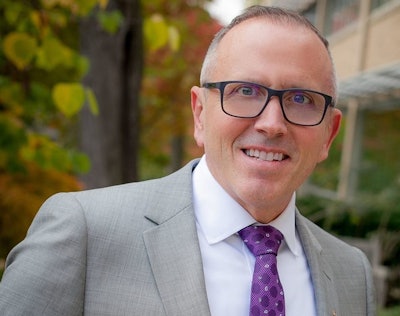More college students than ever were anxious, depressed, and struggling with suicidal thoughts last school year. It’s a disheartening finding from the Healthy Minds Study (HMS), which conducts an annual online survey of nearly 96,000 college students on 133 American campuses that was released last Friday. However, the study did reveal a potential silver lining: more college students than ever are seeking help.
HMS found that 44% of students reported depression, 37% reported anxiety disorders, and 15% reported having seriously considered suicide, increases of two to three percentage points from winter and spring 2021 data. The rates were the highest in the 15-year history of the survey.
 Dr. Justin Heinze, an associate professor in the combined program in education and psychology at the University of Michigan and a principal investigator of the HMS
Dr. Justin Heinze, an associate professor in the combined program in education and psychology at the University of Michigan and a principal investigator of the HMS
Although the pandemic might seem like an obvious explanation for the increase in mental unwellness, Heinze cautioned against attributing the upticks solely to COVID-19.
“We’ve been seeing this trend since at least 2015 and perhaps even a little bit before,” he said. “This just seems to be a continuation.”
Societal factors such as gun violence, climate change, and racial injustice may play a role, according to Dr. John Dunkle, senior director of learning and knowledge at The JED Foundation (JED), a non-profit focusing on young adult mental health and suicide prevention. Heinze thought that some portion of the increases could be attributable to better measurement of mental health and a decrease in the stigmatization of mental health problems. He also pointed out that the issues don’t seem to be beginning in college—adolescents have shown similar increases in mental health problems in other surveys.
Although students are clearly struggling, they are also reaching out for help at higher rates than ever before. 37% of students reported having at least one counseling or therapy session in the previous year, a seven percentage point increase from winter/spring 2021. It was the largest improvement since 2018.
The increase in therapy and counseling may simply be because more students are having mental health problems. But the study also provides evidence of continuing changes in student attitudes about professional help. Only 6% of students said that they would think less of someone who has received mental health treatment, and 40% believed that most people would think less of someone who has received mental health treatment, a decrease of five percentage points from winter/spring 2021.
 Dr. John Dunkle, senior director of learning and knowledge at the JED Foundation (JED)
Dr. John Dunkle, senior director of learning and knowledge at the JED Foundation (JED)
Colleges also seem to have succeeded in making sure that their students know what services are available. 51% of HMS respondents agreed or strongly agreed that if they needed to seek professional help for their mental health, they would know how to get resources from their schools.
Although the 37% of students receiving counseling or therapy was encouraging to Dunkle, he noted that it still falls short of the 52% of students who said that they needed help for mental health problems in the past year. He advocated for schools to examine the survey results more closely to learn about the students who are not receiving professional help.
“I would encourage institutions to dig deeper into the data and start to stratify them based on demographics so that they can really get a deeper understanding of who those 52% are,” he said. “Then they can be more intentional and strategic about getting those students connected to services.”
The HMS did find differences by race: students of color were less likely to access mental health treatment. According to Heinze, this may be attributable to differing levels of mental health stigma in different cultures. He speculated that people of color may be likelier to access other forms of support, through their social or faith networks. Dunkel pointed out that there are relatively few clinicians of color.
“Some want to see mental health professionals who look like them and have shared identities,” he said. “And, in some cases, they may not be too many.”
The study also found changes in the ways that students were interacting with substances. Alcohol use was at its lowest ever, with 54% of students reporting that they had not taken a drink in the two weeks before completing the survey. However, it was unclear whether students were using substances less overall. 22% of students reported using marijuana in the 30 days prior to filling out the survey, a two-point increase from winter/spring 2021. 17% of students reported vaping, also a two-point bump.
Heinze said that an important next step will be the creation of a resource that schools can use to figure out what sorts of mental health programs will best fit their circumstances. He also thought that more schools could have standard mental health check-ins for students and saw potential for online or hybrid mental health support as a means of getting students access to services faster.
But, according to Jennifer Rothman, senior manager for youth and young adult information, support, and education at the National Alliance on Mental Illness, anxiety, depression, and suicidal ideation will likely keep increasing unless underlying causes change.
“I think we’re going to at least see the same numbers for next year because we’re continuing to have the same stressors,” she said. “Our best route is just to put more time and energy and funding into having services available to these students to support them.”
Jon Edelman can be reached at [email protected].





















